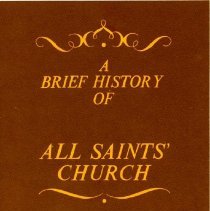Archive Record
Images

Metadata
Object ID |
2009.2007.05 |
Title |
A Brief History of All Saints' Church 1897-1956 |
Object Name |
pamphlet |
Date |
Unknown |
Creator |
Chevy Chase Parish |
Description |
A Brief History of All Saints' Church by Chevy Chase Parish date unknown covers history of All Saints' Church from 1897-1956 Includes photographs and record of reverends the church had information about parish house tower Two copies. A Brief History of All Saints' Church, Chevy Chase Parish. Includes pictures of various church buildings and clergy. 1897 In 1897 the Rector of St. John's Church, Bethesda, instituted mission services in the little school house located where our present Rectory (5 Chevy Chase Circle) stands. At that time Chevy Chase Village was within that Parish. 1901 Ground Breaking The Mission, which had taken the name All Saints, grew and prospered and on June 3, 1901, ground was broken for a church. The cornerstone was laid ten days later by Bishop Satterlee. This was the first church of any denomination to be built in Chevy Chase. 1901 Church The new church, which had a seating capacity of 140 in the pews, was opened and formally occupied on Sunday, December 1, 1901. At that time Chevy Chase Village contained 49 houses and the average church attendance was about 60, with a Sunday School attendance of about 55. 1903 Dr. Childs In 1903 the Convention of the Diocese of Washington created Chevy Chase Parish with All Saints' Church as the parish church. The Vestry called the Rev. Dr. Thomas S. Childs as its first Rector. 1911 The Rev. J.W. Austin In 1911, the Vestry consented to Dr. Childs' request that he be permitted to retire, he having passed his 85th birthday and completed more than 60 years in the ministry. The Vestry named Dr. Childs "Rector Emeritus," and called the Rev. J.W. Austin as Rector. 1914 The church continued to grow, and became inadequate in size even though, by placing chairs in the aisles, up to 200 could be seated. About 1914 Mrs. Anna Kingan gave funds for a Guild Hall which was erected on the south side of the Church. This building has been moved from its original location and is now known as Kingan Chapel. 1936 Kingan Annex Continued growth of the Sunday School prompted the Vestry to undertake construction of an annex to Kingan Chapel. 1922-1924 Continued growth led the Vestry to undertake construction of the present chancel and the eastern half of the Nave. By 1924 the need for additional space was evident. Construction was started on the western half of the Nave to include an undercroft for a Sunday School room and kitchen facilities. Kingan Chapel was moved to its present location. 1923 On April 12, 1923, the Rector, the Rev. J.W. Austin, died very suddenly and the Rev. Henry T. Cocke was called to succeed him. At that time the new church building had been completed and plans were in hand for completing the interior. During the early months of his rectorship, the pulpit, the lectern, the reredos, the altar, and the memorial windows in the chancel were installed as memorials as well as other memorial furnishings. In addition to endearing himself as a pastor his rectorship saw great progress made in reducing the church debt resulting from the construction program. 1943 Dr. Lowry In 1943 failing health forced the Rev. Cocke's resignation. The Vestry called the Rev. Dr. Charles W. Lowry to succeed him. 1949-1953 Parish House Tower An extensive building program was initiated in 1949. It started as a project to build a parish house to provide Sunday School space, a chapel and offices. While plans were being drawn, contracts let and financial pledges sought, an offer of a substantial contribution toward construction of a South Transept was received. It was decided to add this construction was completed, the decision was made to add construction of the Tower and North Transept to the ongoing program and to make the North Transept St. Mary's Chapel. 1953 Dr. Lowry tendered his resignation and the Rev. Fredrick H. Arterton was called to succeed him. Construction of the North Transept having been completed, its furnishing as St. Mary's Chapel was a major project. A major illness necessitated Dr. Arterton's resignation. Dr. Charles E. Berger was called as his successor. 1956 When Dr. Berger assumed the rectorship, he found a large debt from the building program and many problems of personnel of organization. These he moved into vigorously. The debt was paid and we have seen other continuing improvements. Residences were acquired for the two associate rectors, the house at 3903 Oliver Street was purchased for the Sunday School, and the property adjoining the church on Grafton St. was bought for future expansion. All this, except for an amortized mortgage on one of the residences, is entirely free of debt. |
